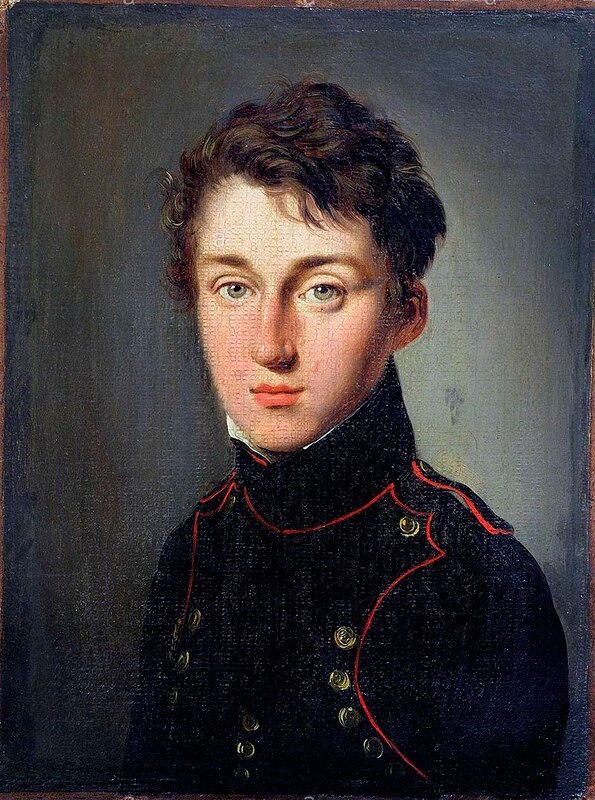Sadi Nicolas Léonard Carnot (01/06/1796- 24/08/1832)
Sadi Carnot was a French physicist born in Paris, often known as the founder of thermodynamics. He is famous for his description of the Carnot cycle: the ideal (adiabatic) cyclical sequence of changes of pressures volume and temperatures of a fluid, such as a gas used in an engine. The Carnot efficiency is used as a standard of performance of all heat engines operating between a high and low temperature.
Carnot was born into a politically unstable time, but fortunately his family was quite well off. His father had been Napoleon’s minister of War, then in 1807 his resigned to educate his son in maths, science, languages and music. After a period of home education, Carnot attended the secondary school, then the Ecole Polytechnique followed by a prestigious two year course in military engineering in Metz.
However, after graduating Carnot failed to find a career path he was truly happy with, so he decided to take the entrance exam for the General Staff Corps in Paris. He was accepted but took leave almost immediately on half pay, and began to study the theory of gases with the help of courses he attended at various Paris universities. Sharing his father’s interest in the new steam engines he soon began to work on a mathematical theory of heat and the modern theory of thermodynamics.
In 1824 he published his only book ‘Reflexions sur la puissance motrice du feu et sur les machines propres à dévélopper cette puissance.’ (Reflexions on the motive power of fire and the machinery to develop this power). This book includes an explanation of the Carnot cycle. Although it was reviewed very positively at the Academy of Sciences it did not achieve much recognition until after his death in 1834.
Carnot retired from the General Staff Corps permanently in 1828 and went to continue his research into theory of heat. Sadly his health deteriorated in 1832 and then he caught cholera which killed him.
Sadi Carnot was a French physicist born in Paris, often known as the founder of thermodynamics. He is famous for his description of the Carnot cycle: the ideal (adiabatic) cyclical sequence of changes of pressures volume and temperatures of a fluid, such as a gas used in an engine. The Carnot efficiency is used as a standard of performance of all heat engines operating between a high and low temperature.
Carnot was born into a politically unstable time, but fortunately his family was quite well off. His father had been Napoleon’s minister of War, then in 1807 his resigned to educate his son in maths, science, languages and music. After a period of home education, Carnot attended the secondary school, then the Ecole Polytechnique followed by a prestigious two year course in military engineering in Metz.
However, after graduating Carnot failed to find a career path he was truly happy with, so he decided to take the entrance exam for the General Staff Corps in Paris. He was accepted but took leave almost immediately on half pay, and began to study the theory of gases with the help of courses he attended at various Paris universities. Sharing his father’s interest in the new steam engines he soon began to work on a mathematical theory of heat and the modern theory of thermodynamics.
In 1824 he published his only book ‘Reflexions sur la puissance motrice du feu et sur les machines propres à dévélopper cette puissance.’ (Reflexions on the motive power of fire and the machinery to develop this power). This book includes an explanation of the Carnot cycle. Although it was reviewed very positively at the Academy of Sciences it did not achieve much recognition until after his death in 1834.
Carnot retired from the General Staff Corps permanently in 1828 and went to continue his research into theory of heat. Sadly his health deteriorated in 1832 and then he caught cholera which killed him.
Sadi Carnot était un physicien français, né en 1796 à Paris. Il est connu comme le fondateur de la thermodynamique et renommé pour sa description du cycle de Carnot.
Il est né dans une famille aisée pendant une période d’instabilité politique. Son père travaille comme ministre de la guerre sous Napoléon mais il démissionne en 1807 pour éduquer son fils en maths, sciences, langues et musique. Carnot est allé au lycée, puis à l’Ecole Polytechnique; et ensuite à École du Génie de Metz. Après avoir obtenu ses diplômes de l’Ecole Polytechniqe et l’Ecole de Metz il travaille comme ingénieur militaire,
En 1824 il publie son seul livre, Réflexions sur la puissance motrice du feu et sur les machines propres à développer cette puissance, où il explique le cycle de Carnot.
Carnot démissione de l’armée en 1828 pour reprendre ses recherches scientifiques à plein temps. Il’s’intéressait surtout au moteurs à vapeur, comme son père et il commence à faire des recherches sur une théorie mathématique de la chaleur et la théorie moderne de la thermodynamique. Malheureusement il meurt prématurément à 36 ans, victime du choléra.
Il est né dans une famille aisée pendant une période d’instabilité politique. Son père travaille comme ministre de la guerre sous Napoléon mais il démissionne en 1807 pour éduquer son fils en maths, sciences, langues et musique. Carnot est allé au lycée, puis à l’Ecole Polytechnique; et ensuite à École du Génie de Metz. Après avoir obtenu ses diplômes de l’Ecole Polytechniqe et l’Ecole de Metz il travaille comme ingénieur militaire,
En 1824 il publie son seul livre, Réflexions sur la puissance motrice du feu et sur les machines propres à développer cette puissance, où il explique le cycle de Carnot.
Carnot démissione de l’armée en 1828 pour reprendre ses recherches scientifiques à plein temps. Il’s’intéressait surtout au moteurs à vapeur, comme son père et il commence à faire des recherches sur une théorie mathématique de la chaleur et la théorie moderne de la thermodynamique. Malheureusement il meurt prématurément à 36 ans, victime du choléra.



 RSS Feed
RSS Feed
